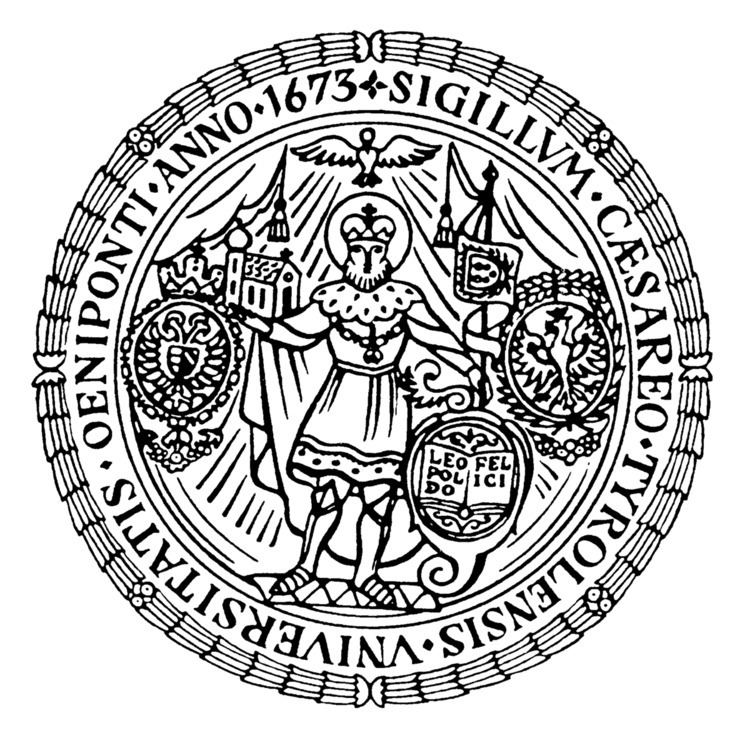Type Public Administrative staff 1,383 Total enrollment 28,185 (2016) Phone +43 512 5070 Rector Tilmann Märk | Established 1669 (as a university) Students 27,774 Campus Urban Founded 1669 Academic staff 3,164 (227 professors) | |
 | ||
Undergraduate tuition and fees 0 EUR (2017), International tuition: 0 EUR (2017) Notable alumni Alexander Van der Bellen, Peter Zoller, Nadine Beiler, Severin Schwan, Gabriel Kuhn Similar Medical University of Innsbru, University of Graz, University of Vienna, University of Salzburg, MCI Management Center In Profiles | ||
The University of Innsbruck (German: Leopold-Franzens-Universität Innsbruck; Latin: Universitas Leopoldino Franciscea) is a public university in Innsbruck, the capital of the Austrian federal state of Tyrol, founded in 1669.
Contents
- University of innsbruck brand research laboratory english
- History
- Ceremonial Equipment
- The faculties
- Buildings
- Points of interest
- Nobel laureates
- Notable faculty
- Notable alumni
- Victims of political persecution and terror
- References
It is currently the largest education facility in the Austrian Bundesland of Tirol, the third largest in Austria behind Vienna University and the University of Graz and according to The Times Higher Education Supplement World Ranking 2010 Austria's leading university. Significant contributions have been made in many branches, most of all in the physics department. Further, regarding the number of Web of Science-listed publications, it occupies the third rank worldwide in the area of mountain research.
University of innsbruck brand research laboratory english
History
In 1562 a Jesuit grammar school was established in Innsbruck by Peter Canisius, today called "Akademisches Gymnasium Innsbruck". It was financed by the salt mines in Hall in Tirol, and was refounded as a university in 1669 by Leopold I with four faculties. In 1782 this was reduced to a mere lyceum (as were all other Universities in the Austrian Empire, apart from Prague, Vienna and Lviv), but it was reestablished as the University of Innsbruck in 1826 by Emperor Franz I. The university is therefore named after both of its founding fathers with the official title "Leopold-Franzens-Universität Innsbruck" (Universitas Leopoldino-Franciscea).
In 1991 Lauda Air Flight 004 crashed in Thailand, killing all aboard, including 21 members of the University of Innsbruck. The passengers included professor and economist Clemens August Andreae, another professor, six assistants, and 13 students. Andreae had often led field visits to Hong Kong.
In 2005, copies of letters written by the emperors Frederick II and Conrad IV were found in the university's library. They arrived in Innsbruck in the 18th century, having left the charterhouse Allerengelberg in Schnals due to its abolishment.
Ceremonial Equipment
In the 1850s, the Habsburgs gradually closed the University of Olomouc as a consequence of the Olomouc students' and professors' participation in the 1848 revolutions and the Czech National Revival. The ceremonial equipment of the University of Olomouc was then transferred to the University of Innsbruck. The original Olomouc ceremonial maces from the 1580s are now used as the maces of Innsbruck University and Innsbruck Medical University. Olomouc University Rector's mace from ca. 1572 is nowadays used as the mace of the Innsbruck Faculty of Theology and Olomouc Faculty of Law Dean's Mace from 1833 is nowadays used as Innsbruck's Faculty of Law Mace.
Since the establishment of Czechoslovakia in 1918, the Czechs have been unsuccessfully requesting the return of the University of Olomouc's original ceremonial equipment. Many years later, in 1998, Innsbruck donated an exact copy of the Rector's Mace to Palacký University, but it is still, in 2015, using the Olomouc University original maces and other regalia as its own ceremonial equipment.
The faculties
The new plan of organisation (having become effective on October 1, 2004) installed the following 16 faculties to replace the previously existing six faculties:
As of 1 January 2004, the Faculty of Medicine was sectioned off from the main university to become a university in its own right. This is now called the Innsbruck Medical University (Medizinische Universität Innsbruck).
Buildings
The university buildings are spread across the city and there is no university campus as such. The most important locations are:
